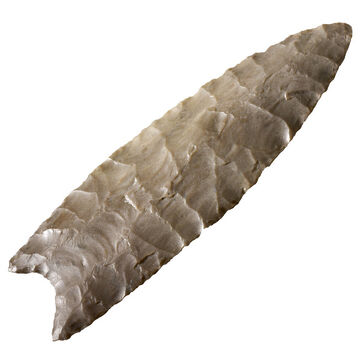Brief Identificaion[]

Stone Clovis Spear Point Found in Arizona
This object is a Clovis Blade. It would have been attached to a long stick and used by the Clovis People as a spear for hunting the Megafauna that inhabited prehistoric America. The term “Clovis” comes from the town of Clovis, New Mexico , near which the first evidence of this culture was found in the 1930’s. Since then, archeologists have found evidence of this culture in areas ranging from Alaska to the tip of South America, although most sites are found in the American Southwest [Collins 1999, 3-4].
This particular object dates to around 11,000 BCE, and was found in Arizona. This Blade is made of stone and measures 8.5 cm long and 3 cm across with a diameter of 0.7 cm, small enough to fit in the palm of one's hand but, properly wielded, deadly to any animal.
Technical Evaluation[]
This object was made by a Clovis man through a process known as “pressure flaking .” Flaking entailed taking a stone and using a hard stone or similar material, possibly antler or bone, to chip small pieces off of the blank; therefore creating a sharp, cutting edge. This process not only sharpened the stone into a cutting tool, but the depressions that were created would tear a gaping wound into its target, causing the animal to bleed out. This eliminated the need to strike killing blows in vital organs in the animal. The pack of hunters could simply strike a couple of blows with their spears and then follow the animal until it died from its wounds [Boldurian and Cotter 1999, 93-94].
Most Clovis Blade specimens that have been found are bifacial, meaning both sides of the stone had sharp edges put on them. However there have been some examples found that are unifacial, only having an edge on one side, as well as some that are curved, like a sickle, as opposed to being straight like a traditional spear head [Collins 1999, 7-9].
This blade-making technology was advanced on the American continents, but when compared to other civilizations in the world, the Clovis people were very behind. While the peoples in the Americas were hunting Wooly Mammoths with spears, people in Eurasia had already begun domesticating animals and becoming agriculturalists. These spear points are relatively simple, with no intricate designs or precious materials or advanced techniques needed to create them. Yet they play a vital role to the survival of the Clovis people as well as being one of the major factors in the extinctions of Megafauna from the American Continents.
Examples of Clovis Blades have been found in numerous sites throughout the American Continents and are popular pieces in Natural History Museums, including The British Museum, in London, England, where the pictured specimen is located, in Room 26 in the North American exhibit, to be exact.
Local Historical Context[]
The Clovis peopl developed the technique to make these spear heads when they were settling the American continents and hunting the Megafauna that roamed the American plains. Archeological evidence suggests that the Clovis people of the modern day southwestern United States traveled in small, nomadic bands, tracking the large animals that they used for food. These pastoral bands were small, centralized, family based units as the lifestyle provided no stable food source and could not support large groups of people. Because of the nomadic existence the Clovis people led, no real social hierarchy developed, there was no such thing as a parasitic occupation (bureaucrat, warrior, politician, etc.). The spear points were a crucial piece of Clovis life. Everything from food to clothing depended on the ability to fell a large animal. It was the foundation for the Clovis existence and therefore a vital tool for the Clovis people [Huckell 2004, 96].
World-Historical Context[]
This particular artifact is noteworthy in the tale of global historical because it is an example of how the first settlers of the American Continents adapted to their environment and drastically changed the ecology of the land. Before the Clovis people, animals dominated the American landscape. However, upon their arrival, these Paleo-Indian people arrived on the scene and positioned themselves on the top of the food chain, driving many species of Megafauna into extinction [Haynes 2002, 109-110]. Because of the adjustments the Clovis were able to make, namely being their lithic blades, the stage was set for Homo sapiens to thrive on the new continents in the same way that stone hand axes did on the Eurasian Continent thousands of years before .
Suggested Bibiliography[]
Boldurian, Anthony T., and John L. Cotter. Clovis Revisited: New Perspectives on Paleoindian adaptations from Blackwater Draw, New Mexico. Philadelphia: University of Pennsylvania Museum, 1999.
Collins,Michael B.. Clovis Blade Technology. Texas Archaeology and Ethnohistory Series. Thomas R. Hester. Austin: University of Texas Press, 1999.
Haynes, Gary. The Early Settlement of North America: The Clovis Era. Cambridge: Cambridge University Press, 2002.
Huckell, Bruce B.. “Clovis in the Southwestern United States.” New Perspectives on the First Americans. edited by Bradley T. Lepper and Robson Bonnichsen. 93-101. College Station: Texas A&M University Press, 2004.
North, Chris D., Michael S. Foster, John M. Lindly, and Douglas R. Mitchell. “A Newly Discovered Clovis Point from the Phoenix Basin and an Update on Arizona Clovis Point Attributes.” Kiva. 70.3 (2005): 293-307.
Mourre, Vincent, Paola Villa, Christopher S. Henshilwood. “Early Use of Pressure Flaking on Lithic Artifacts at Blombos Cave, South Africa.” Science 330.6004 (29 October 2010): 659-662. Accessed April 17, 2011. doi: 10.1126/science.1195550. http://www.sciencemag.org/content/330/6004/659.full
“Clovis Spear Point.” A History of the World in 100 Objects. BBC: 22 Jan 2010. Radio. 18 Apr 2011. http://www.bbc.co.uk/programmes/b00pwn7t.
Britannica Online, "Paleolithic Period" http://www.britannica.com/EBchecked/topic/439507/Paleolithic-Periodi
The British Museum. "Clovis Point Spear Tip." Acessed April 15, 2011. http://www.britishmuseum.org/explore/highlights/highlight_objects/pe/c/clovis_point_spear_tip.aspx
The British Museum. "Olduvai Handaxe." Acessed April 19, 2011. http://www.britishmuseum.org/explore/highlights/highlight_objects/pe/s/olduvai_handaxe.aspx
The Center for Desert Archeology. “A Century of Paleoindian Archaeology in the Southwest.”Acessed April 15, 2011. http://www.cdarc.org/what-we-do/exhibits/rethinking-the-peopling-of-the-americas/a-century-of-paleoindian-archaeology-in-the-southwest/.
Texas Beyond History. “Clovis Reconsidered.”Acessed April 15, 2011. http://www.texasbeyondhistory.net/gault/clovis.html.